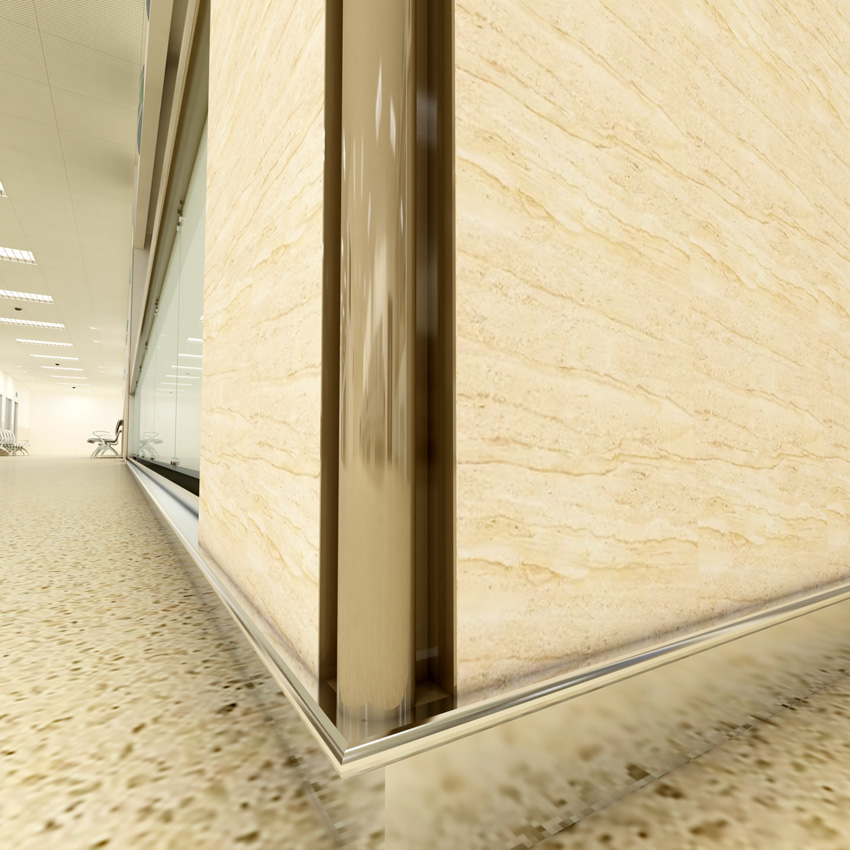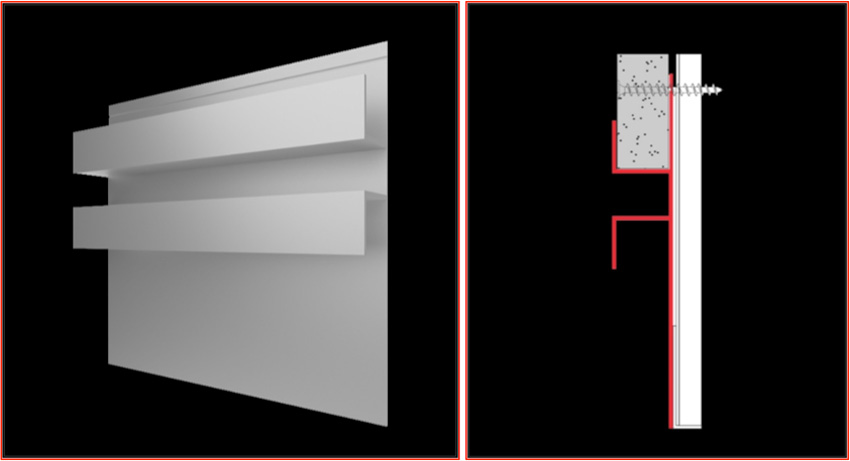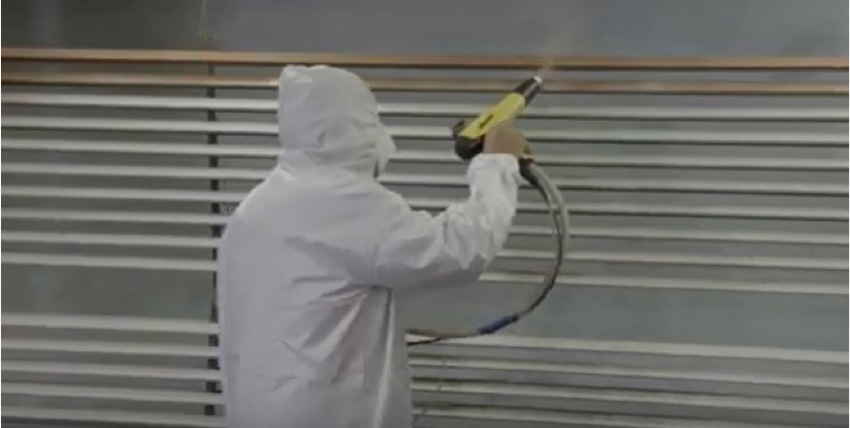Specifying Extruded Aluminum Trim for Drywall Surfaces in Multifamily Residential Projects
Profiles and Finishes Available for Extruded Aluminum

Extruded aluminum trim can be used for many different interior purposes, such as bases and corners, and it can have many different finishes and polishes.
There are many different extruded aluminum trim products available in just about every size, style, and type any project would need. Products such as bases, recessed reveals, corner transitions, and recessed channels that hold three-dimensional inserts of various shapes and sizes are options for designers. Each profile can impact the interior design of a project in subtly different ways, but a common factor is that as extruded aluminum, they are all precisely manufactured under extreme tolerances to produce highly refined results without master craft skilled labor. In addition to the many profiles, products are also available in a variety of metallic finishes—but they also can be primed for custom in-field painting. With so many options, designers can blend the extrusions in with the surface, or use them as a design feature and focus in a room. This section will walk through some of the more common profiles and finishes, and discuss some of the more unique and complex shapes available for extruded aluminum trim.
Baseboard Details
Baseboard details, which are decorative moldings used to cover the joint between the finished wall and the floor, also protect the wall from abrasion and kicks in high-traffic areas. These prominent details are important enough to warrant a quick overview of some of the more common base options. A standard base detail is usually a 3½-inch profile that is installed on top of the drywall. With some applications, quarter round is used as a flooring joint between the flooring and the baseboard to improve the overall aesthetics. While baseboards are still fairly common, some designers question the utility of the traditional baseboard, and that has led to newer, more contemporary options for the design community.
One approach is to simply eliminate the baseboard. Without a baseboard, the wall-to-floor connection creates a simple, minimalistic aesthetic. This option reduces the material used for a project, shortens overall installation time, and eliminates the costs associated with installing and finishing a conventional baseboard. While the look may be clean and minimalist, this approach leaves the wall base susceptible to damage from foot traffic and equipment, so it lends itself more to industrial or commercial applications rather than residential projects.
If a “no-base” approach is used, the joint between the wall and floor should be kept open with a ¾-inch reveal (shadow line) to allow the surfaces to move independently. This reveal can be accomplished by separating the drywall from the floor with a piece of Z-metal. It also requires taping off the lower edge of the drywall. Overall, there is less tolerance for error in the drywall finishing process than with a more traditional baseboard trim.
Another commonly used base is the “flush base.” This base is typically 3½ or 5½ inches, and is recessed so that it is flush against the wall—thus the name. This base style provides a clean, sleek look that works well with a modern interior. Some of the more common materials for a flush base include wood and medium-density fiberboard (MDF). This approach requires considerable planning, work, and care to install, but once it is done, it protects the wall and helps minimize dust collection. Prior to installation, the finished wall surface and base should be fastened to the same underlying substrate to prevent the joint from cracking.
A “reveal base” is a popular technique in modern architectural design. It is used to separate and express the joint between materials to create a shadow line between the two surfaces. This base works especially well when used to separate two different materials, in which case it can create the illusion of the wall floating off the floor. Reveal bases can be custom made of just about any material, but they are typically made of metal or plastic, and they offer designers tremendous flexibility. Key features of a reveal base are a clean edge that is easy to finish, and a wide range of sizes and profiles. Reveal bases also can be painted, giving designers the option of using matching or contrasting colors, as well as incorporating the reveal into the larger design statement of the project, whether through door and window trim, or other features.
Extruded Aluminum Trim Profiles
Given everything we have discussed about the different types of bases available, let’s talk about how extruded aluminum trim fits into the picture. Extruded aluminum bases, for example, can be used to satisfy a wide range of design requirements. These bases are installed horizontally and can be used in different configurations, such as a projecting square or a reveal double flange.
Extruded aluminum is also well suited for reveals. These reveals can be installed in numerous ways, including vertically, horizontally, and diagonally, and they are available in many different styles to meet the needs and requirements of different designers. For example, square reveals, which are strictly decorative, can be used to create shadow lines or to include a break or separation between materials. The effect is an appealing recess that can be installed vertically, horizontally, or diagonally. Square reveals are available in a range of widths from ¼ inch to 4 inches, and are made of either PVC vinyl or aluminum.

Reveal double flanges provide a reveal for visual impact all while protecting the bottom of the wall material.
Channels are another profile option, and they are available in flush square, square tapered, and square angled designs. Flush square channels are a two-part system that includes channels and inserts, which are typically installed vertically and diagonally; however, if the project conditions are approved, the channels can be installed horizontally. These channels have a ridged face that can be used for taping and floating and allows the insert piece to look as if it is freestanding.
Channels are also available in square-tapered and square-angled configurations, which can create a dynamic look when paired with an insert piece, such as a rectangular square, a projecting radiused square, or a blade rectangular round.
Finally, corner trim profiles, usually made with PVC rubber or aluminum, can be used to protect vertical drywall or corner edges, all through a range of design options. Corner trim made from extruded aluminum is considerably more durable and longer lasting than those made from PVC, and there are far more design options available. With aluminum, designers can create beautiful lines, reveals, and shadows to emphasize surfaces and features in a room. The corner trim options available in aluminum are also varied, with square, radiused, round, elliptical, and tapered designs.
Extruded Aluminum Finishes and Polishes
In addition to a variety of aluminum trim profile designs to choose from, architects and designers also have the luxury of having an extensive choice for finishes and polishes. Aluminum trim products are available in a variety of finishes, including ready-to-paint finishes for custom color matching using liquid paints (such as acrylics, alkyds, or polyester, and others) or powder coatings. They are also available in clear and colored anodized finishes.
Anodizing is an electrochemical process that changes a metal’s surface into an anodic oxide finish that is decorative, durable, and corrosion resistant. Aluminum’s physical characteristics make it ideally suited for anodizing treatments. In fact, unfinished aluminum will oxidize naturally when exposed to air, but the artificial oxide film from the anodizing process is thicker, harder, and more durable.
One of the main benefits of anodized aluminum is that, unlike paint or plating, the aluminum oxide is completely integrated with the underlying aluminum substrate. This means that it won’t chip or peel. Another benefit is that the anodized surface has a porous structure that makes a secondary process such as coloring and sealing very easy.
Clear anodized finishes are used to protect the surface and let the natural metallic color of the aluminum be featured. Generally speaking, there is no need to paint anodized trim—in fact, it’s not recommended—but in some cases, it may be necessary. In such cases, designers may first want to see what primed-and-ready-to-paint profiles are provided by the manufacturer. If the desired styles are not available, the moldings must be cleaned with an acid etch solution, rinsed thoroughly, and given time to dry. A primer should be used as a base coat—ideally recommended by the paint manufacturer—followed by the paint.
One of the more popular finishing options for aluminum trim is powder-coated finish. In fact, more than 15 percent of the total industrial finishing market uses powder-coated finishes. The finish is popular not only because it is extremely high quality but also because it has a virtually limitless range of colors.

Powder-coated finishes provide extruded aluminum trim with high-quality finishes in an almost limitless range of colors. The finish is applied to the substrate through electrostatic spray deposition to provide an even finish that is more durable than liquid paint.
Part of powder coating’s popularity also stems from how it is produced and how resilient the final product is. These coatings are based on polymer resin systems, blended with curatives, pigments, leveling agents, flow modifiers, and other additives. The ingredients are melt mixed, cooled, and then ground into a powder. Once the powder is formed, it is applied to the aluminum substrate using a process known as electrostatic spray deposition (ESD). After the powder has been applied, the substrate is heat cured; during this process, the coating chemically reacts to produce long molecular chains that are very strong and do not break down easily. This coating is much more durable than liquid paints. Where liquid paints are prone to eventual diminished quality from exposure to moisture, harsh weather, chemicals, and ultraviolet light, powder-coated aluminum is much stronger. As a more durable finish, powder coating resists scratches, chipping, corrosion, fading, and other wear issues that are known to negatively impact liquid painted surfaces.
Recently, designers such as Wayne Braun, former design director at PDR, have teamed up with extruded aluminum trim manufacturers to create a line of products designed and manufactured to move beyond just enhancing all of the practical aspects of drywall construction and instead transform drywall into a the most impactful element of a well-designed space. In Braun’s case, he has helped design everything from basic aluminum extrusions that include simple reveals and transitions to more complex shapes that include “recessed reveals, corner transitions, edge transitions, and recessed channels that hold three-dimentional inserts of various shapes and sizes. All trim work can be applied to walls and ceilings and floated in flush with a gypsum board surface or installed with panels such as wood, glass, or tile work.”1 With more designers influencing extruded aluminum trim, the opportunities for unique drywall interiors will continue to grow as a trend.









